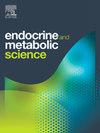伊朗桂兰地区2型糖尿病患者甲状腺功能障碍状况调查
Q3 Medicine
引用次数: 0
摘要
目的探讨2型糖尿病患者甲状腺功能障碍的患病率及其相关危险因素。方法对223例2型糖尿病(T2DM)患者进行横断面研究。根据是否存在甲状腺疾病将患者分为两组。收集了人口统计学、临床和实验室数据,并通过比较有和无甲状腺功能障碍的糖尿病患者来评估与甲状腺疾病相关的危险因素。采用SPSS version 22进行统计分析,显著性水平设为P <;0.05.结果患者平均年龄54.24±9.73岁,女性占72.6% (n = 162)。T2DM患者中甲状腺疾病的患病率为61.9%,其中甲状腺功能减退最为常见(45.7%)。心血管疾病是最常见的糖尿病相关并发症(43.9%),而肾病的患病率最低(40.8%)。神经病变、肾病和心血管疾病在甲状腺疾病患者中的发生率明显高于无甲状腺疾病患者(P <;0.05)。40.4%的患者有甲状腺疾病家族史,17.0%的患者抗甲状腺过氧化物酶抗体阳性。甲状腺疾病在女性中的患病率(67.9%)高于男性(45.9%)(P = 0.003)。女性和阳性家族史是发生甲状腺疾病的重要危险因素(P <;0.05)。结论女性和甲状腺家族史是2型糖尿病患者甲状腺功能障碍的重要预测因素。这些发现强调了对这类患者进行甲状腺疾病常规筛查的必要性。本文章由计算机程序翻译,如有差异,请以英文原文为准。
The status of thyroid disorders among patients with type 2 diabetes mellitus in Guilan province, Iran
Aims
This study aimed to investigate the prevalence of thyroid disorders and their associated risk factors in patients with type 2 diabetes mellitus.
Methods
This cross-sectional study was conducted among 223 patients with type 2 diabetes mellitus (T2DM). Patients were categorized into two groups based on the presence or absence of thyroid disorders. Demographic, clinical, and laboratory data were collected, and risk factors associated with thyroid disorders were evaluated by comparing diabetic patients with and without thyroid dysfunction. Statistical analysis was performed using SPSS version 22, with the level of significance set at P < 0.05.
Results
The mean age of patients was 54.24 ± 9.73 years, and 72.6 % (n = 162) were female. The prevalence of thyroid disorders among patients with T2DM was 61.9 %, with hypothyroidism being the most common (45.7 %). Cardiovascular disease was the most frequent diabetes-related complication (43.9 %), while nephropathy had the lowest prevalence (40.8 %). Neuropathy, nephropathy, and cardiovascular disease were significantly more frequent in patients with thyroid disorders compared to those without (P < 0.05). A family history of thyroid disease was present in 40.4 % of patients, and 17.0 % were positive for anti-thyroid peroxidase antibodies. Thyroid disorders were more prevalent in females (67.9 %) compared to males (45.9 %) (P = 0.003). Female gender and a positive family history were significant risk factors for developing thyroid disorders (P < 0.05).
Conclusion
This study demonstrated that female gender and a positive family history of thyroid disease are significant predictors of thyroid dysfunction in patients with T2DM. These findings underscore the need for routine screening for thyroid disorders in this patient population.
求助全文
通过发布文献求助,成功后即可免费获取论文全文。
去求助
来源期刊

Endocrine and Metabolic Science
Medicine-Endocrinology, Diabetes and Metabolism
CiteScore
2.80
自引率
0.00%
发文量
4
审稿时长
84 days
 求助内容:
求助内容: 应助结果提醒方式:
应助结果提醒方式:


